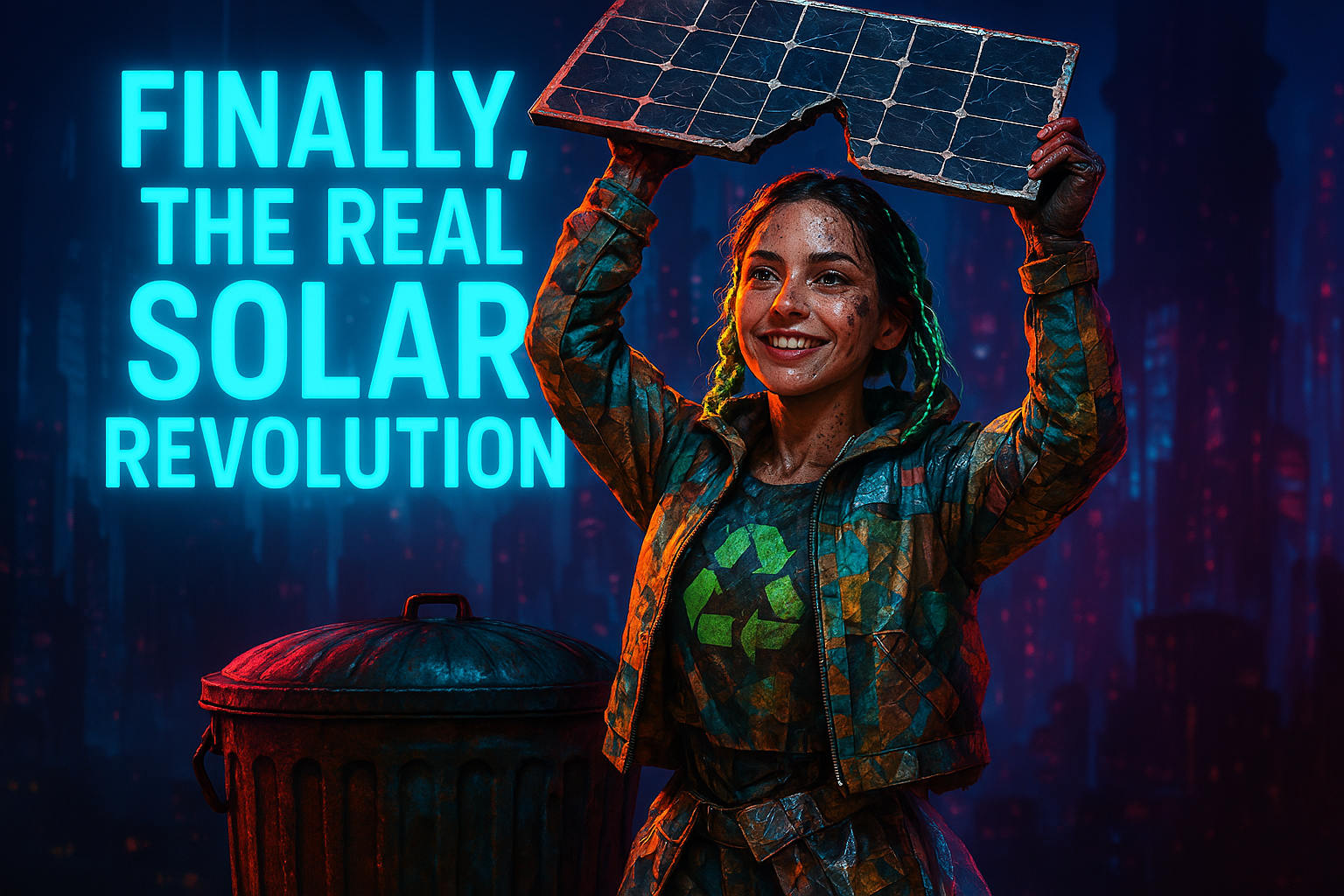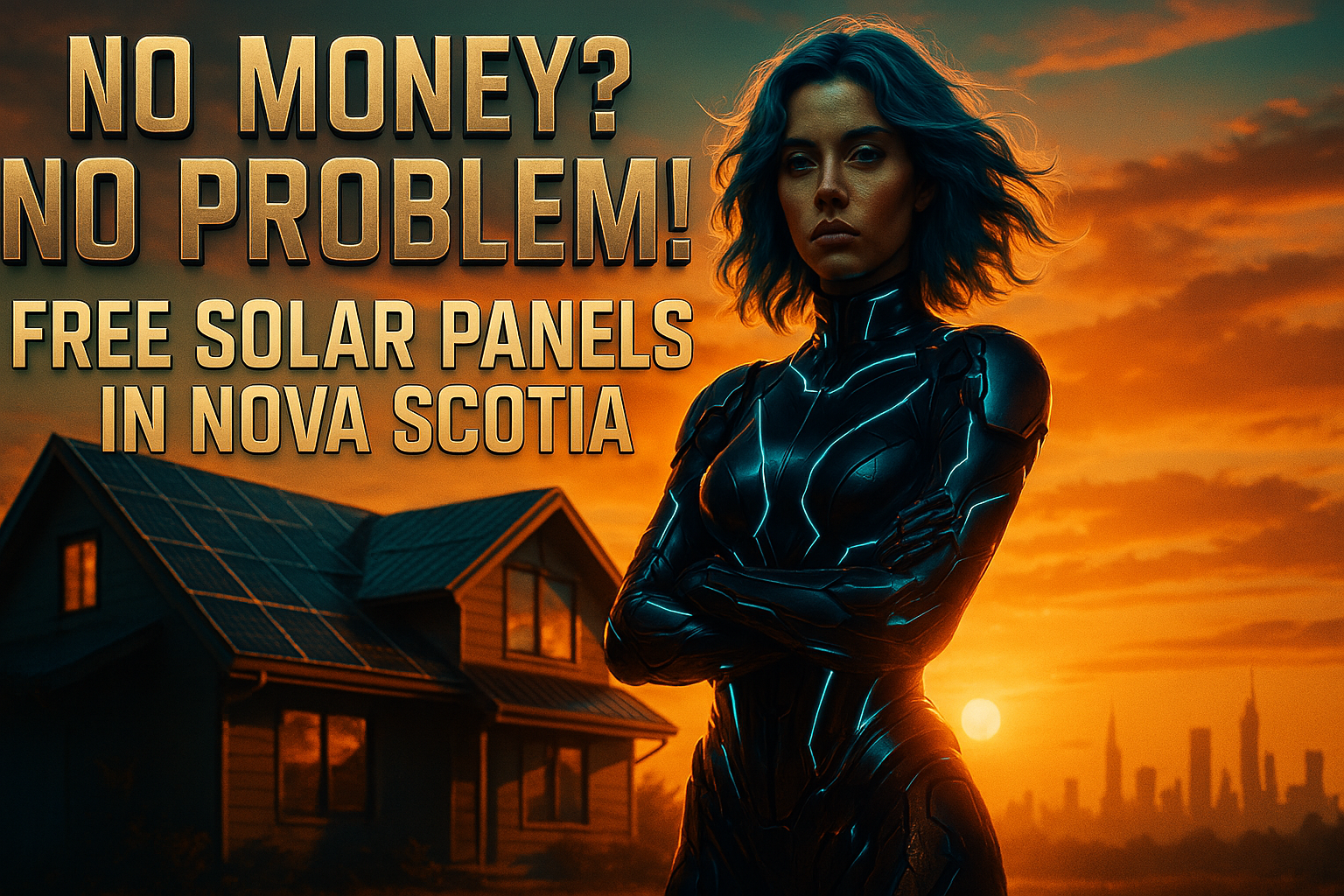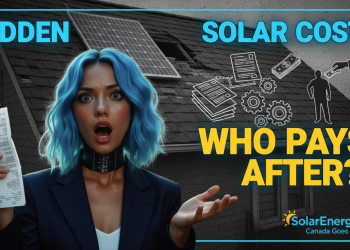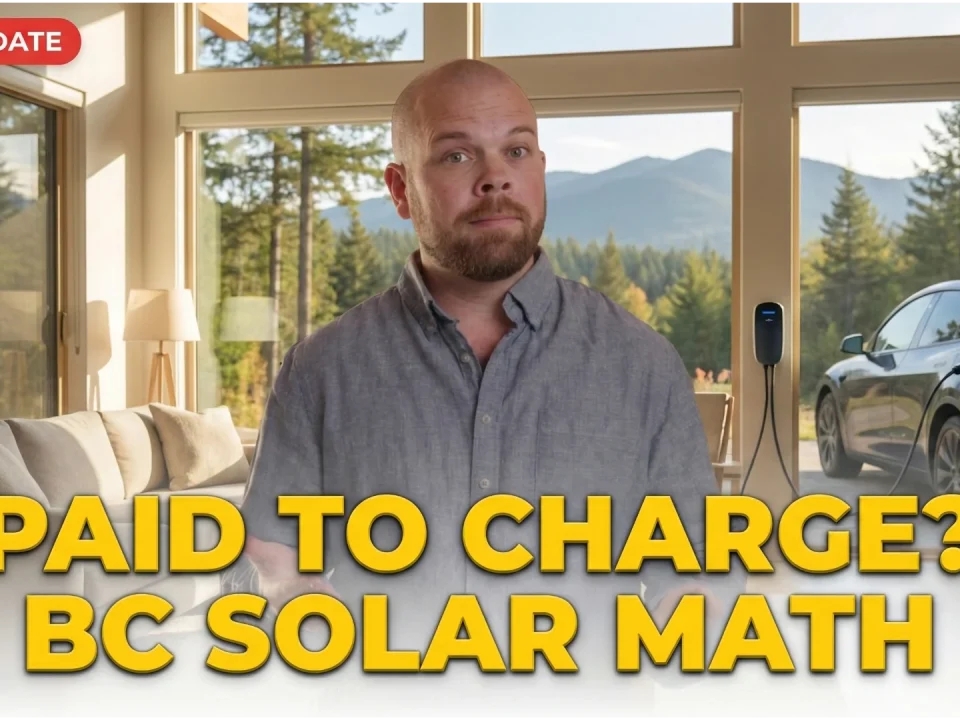
Can You Sell Electricity Back to the Grid in Nova Scotia?
April 1, 2025
Perovskite Solar Cells Explained With Prices And Actionable Steps
April 3, 2025You’ve probably heard whispers, maybe seen ads: “Free Solar Panels in Nova Scotia!” Isn’t that an incredible offer? Almost too good to be true. That’s what brings many folks here, wondering if it’s legit or just another sales pitch.
Let’s be real, the idea of wiping out your power bill for free is tempting. But, as someone who digs into how solar companies really operate, I can tell you it’s usually not that straightforward. Is it a total scam? Not always, but the word “free” needs a closer look. This article breaks down what those “free” offers actually mean, who really qualifies for the genuine help available, and how to avoid getting tangled in a bad deal.
What “Free” Really Means: Digging Past the Sales Talk
Let’s get this out of the way: genuinely free solar panels, where someone installs a full system on your roof with zero cost or obligation ever? That’s not a thing in Nova Scotia. That “free” you see in ads? It’s mostly just a marketing tactic. Often, it points toward financing models like solar leases or Power Purchase Agreements (PPAs).
Here’s the deal with those:
- Solar Leases: You pay a monthly fee to rent the panels from a company. They install and maintain them, but you don’t own them. Your upfront cost might be zero, but you’re locked into payments for maybe 20–25 years. You usually don’t qualify for rebates or tax credits yourself.
- PPAs: Similar to leases, a company installs panels you don’t own. Instead of a flat lease fee, you agree to buy the electricity the panels produce at a set rate per kilowatt-hour (kWh), again for a long term. The rate might be lower than Nova Scotia Power’s, but you still pay, and you don’t own the gear.
While these can lower the initial barrier, they aren’t free. You don’t own the system, so you miss out on the long-term asset value and the eventual truly free power once a purchased system is paid off. The Federal Trade Commission (FTC) even warns that “free solar” offers are often scams. Genuine government help comes as rebates or loans to reduce the cost, not eliminate it entirely.
Latest Solar Updates: Rebates and Program Shifts in Nova Scotia
The solar scene changes, so staying updated is key. Here’s what’s current for Nova Scotians:
Federal Programs
- Canada Greener Homes Grant: This popular $5,000 federal grant is closed to new applicants as of February 2024. If you already had an active application in Nova Scotia, you should still be processed via Efficiency Nova Scotia’s Home Energy Assessment (HEA) program. It offered $125 to $5,000 for retrofits, including solar.
- Canada Greener Homes Loan: This one’s still active and a big help! It offers interest-free loans from $5,000 up to $40,000 to finance energy upgrades, including solar PV systems. The repayment term is 10 years. You need to own the home (primary residence), get a pre-retrofit EnerGuide evaluation, and have decent credit. You can even get up to 15% upfront to help start the work. This is a fantastic way to finance a system without paying interest.
- Clean Technology Investment Tax Credit: This program is mainly for businesses, but it offers a 30% refundable tax credit on the cost of clean tech like solar and batteries. If you run a home business, it might be relevant.
Provincial Power (Efficiency Nova Scotia)
- SolarHomes Program: This initiative is the main provincial rebate. It offers $0.30 per watt for approved solar PV systems, capped at $3,000 (for systems up to 10 kW). For many homes, this incentive knocks about 16% off the system cost. Eligibility requires owning your primary residence or seasonal property, getting pre-approval before installation, and using an installer registered with Efficiency Nova Scotia. You can only get this rebate once per property, and rentals don’t qualify.
- Solar for Non-Profits Pilot: Helps registered non-profits go solar with a rebate of $0.60/watt, up to 25% of costs or $15,000.
- Home Battery Pilot: As of Jan. 17, 2025, the program for battery storage rebates is no longer open to new applicants. It previously offered up to $2,500.
- Agriculture Clean Technology Program: Offers farmers up to 60% of project costs (max $150,000) for clean tech like solar.
- Community Solar Program: Allows people to subscribe to a local solar garden and get credits ($0.02/kWh currently) on their power bill without installing panels themselves. Good for renters or those with unsuitable roofs.
Municipal Initiatives (PACE Programs)
- Halifax Solar City Program: A great program! Halifax offers financing for solar installations (electric, hot air, and water) via a Local Improvement Charge (LIC) added to your property tax bill. You repay it over 10 years at a fixed 4.75% interest rate. It covers the full cost, making it feel like “no money down.” Eligibility requires being up-to-date on property taxes. You choose the contractor, but HRM reviews them. If you sell, the charge stays with the property or can be paid off.
- Clean Energy Financing (PACE) in Other Towns: Many other municipalities (Amherst, Bridgewater, Cumberland, Digby, Lunenburg, New Glasgow, Victoria County, Colchester, etc.) have similar PACE programs. Terms vary, but they offer low-interest loans ($10k-$40k typically) paid via property taxes over a period of 10–15 years. Some, like Solar Colchester initially, even offered 0% interest (though Solar Colchester is now 4.75%). Check www.CleanEnergyFinancing.ca or your local municipal office.
Tip for Staying Current: Always check official sources like the Natural Resources Canada website, the Efficiency Nova Scotia site, and your municipal government’s website for the latest program details and availability. Things change.
Common Scams and Red Flags: How to Protect Yourself
With high electricity rates and strong interest in solar, Nova Scotia is unfortunately attractive to scammers. Here’s what to watch out for:
Scam Tactics:
- The “Free” Pitch: As discussed, be highly skeptical of completely free offers.
- Fake Government Links: Scammers might falsely claim affiliation with Efficiency Nova Scotia or federal programs. Always verify programs directly on official websites.
- High-Pressure Sales: Pressuring you to sign contracts with “limited-time offers” or using fear tactics about rising energy costs is a red flag. Legitimate companies give you time to think.
- Unsolicited Contacts: Be wary of unexpected door-knockers or cold calls pushing solar deals.
- Large Upfront Payments: Demanding big deposits before work starts, especially via unusual methods (gift cards, crypto), is suspicious.
- Exaggerated Savings: Promises of eliminating your bill entirely or unrealistic savings/rebates that don’t match official programs.
- Vague Contracts: Contracts that lack clear details on costs, equipment, warranties, or cancellation policies.
- Impersonation: Pretending to be from Nova Scotia Power or a government agency.
Red Flags to Spot:
- Too Good to Be True: If it sounds unbelievable, it probably is.
- Pressure to Sign NOW: Avoid salespeople who won’t let you sleep on it or get other quotes.
- Lack of Credentials: Reputable installers are registered with Efficiency Nova Scotia. Check their licensing and certifications.
- Poor Online Presence/Reviews: Check for reviews, complaints (for instance, on the Better Business Bureau), and a professional website.
- Incomplete Paperwork: Vague contracts are a no-go.
I recommend always getting multiple quotes (at least three!) from installers registered with Efficiency Nova Scotia. You can find them through the Efficiency Trade Network or Solar Nova Scotia’s directory. Don’t just trust the salesperson; verify program details yourself.
If you come across a scam, please report it. Use the FTC’s ReportFraud.FTC.gov, contact your provincial consumer protection office, check with the Better Business Bureau, or use SEIA’s complaint form. Nova Scotia Power also has scam prevention info.
Who Qualifies for Rebates and Financing? Breaking Down Eligibility
Let’s clarify who can actually use solar incentives. Eligibility varies by program:
Efficiency Nova Scotia SolarHomes Rebate ($3,000 Max)
- Applicant: Must be a homeowner.
- Property: Must be your primary residence OR primary seasonal property in Nova Scotia. This property should not be available for rental purposes.
- Process: Need pre-approval before installing. You must use an Efficiency Nova Scotia-registered installer.
- System: Must be new, minimum 1 kW size.
- Limit: One rebate per property, ever.
Canada Greener Homes Loan ($40,000 Max, Interest-Free)
- Applicant: Canadian citizen, permanent resident, or legally authorized non-permanent resident.
- Property: Must own it, and it must be your primary residence.
- Prerequisites: Need a pre-retrofit EnerGuide evaluation done after April 1, 2020. The retrofits have not yet begun.
- Financials: Good credit history required.
Halifax Solar City Program (Municipal Financing)
- Applicant: Property owner within Halifax Regional Municipality (HRM). This includes residential properties, non-profit organizations, places of worship, cooperatives, and charitable organizations.
- Financials: All property taxes and other municipal fees must be paid and current.
Other Municipal PACE Programs (Vary by Town)
- Applicant: Typically property owners within the specific municipality offering the program (e.g., Colchester, Bridgewater).
- Financials: Similar requirements to Halifax—usually need to be current on property taxes. Check your local municipality’s specific rules.
Tip for Eligibility: Property ownership and primary residence status are common threads for homeowner programs. Location matters hugely for municipal programs. Always double-check the specific criteria for the program you’re interested in before applying.
Pricing and Financing Explained: What’s the Real Cost?
Let’s talk numbers. Installing solar isn’t pocket change, but incentives make a big difference.
Typical Costs of Solar Panels in Nova Scotia
A standard residential solar system generally lands somewhere between $20,000 and $35,000 before incentives. Smaller systems might be under $20,000, while larger ones, especially with battery backup, could top $40,000. The average cost per watt sits around $2.60 to $3.27. Installation costs add around $1,100 to $1,600 per kW.
Here’s a rough idea of how incentives could impact costs* (using an average $2.90/watt; remember the Greener Homes Grant is closed now but shown for context):
| System Size | Est. Cost (Before Incentives) | Est. Cost After SolarHomes Rebate | Est. Cost After SolarHomes + Old Greener Homes Grant |
|---|---|---|---|
| 5 kW | $14,500 | $11,500 (max. $3,000 rebate met) | $6,500 |
| 7 kW | $20,300 | $17,300 (max. $3,000 rebate met) | $12,300 |
| 10 kW | $29,000 | $26,000 (max. $3,000 rebate met) | $21,000 |
*Estimates only; actual costs vary.
A 5kW system potentially dropping to $11,500 with just the SolarHomes rebate makes it much more manageable.
What Influences the Price Tag?
- System Size: Bigger energy needs = bigger system = higher cost.
- Equipment Quality: Higher efficiency panels or premium inverters cost more upfront but might perform better long-term. Think about things like microinverters vs. string inverters.
- Roof Complexity: Steep pitch, multiple angles, or difficult access can increase labor costs.
- Battery Storage: Adding batteries for backup power adds significantly, around $5,000 – $15,000.
- Monitoring Systems: Options range from basic tracking to advanced AI systems.
Financing Your System
You don’t necessarily need cash upfront. There are different financing options available:
- Canada Greener Homes Loan: Interest-free up to $40,000 is hard to beat.
- Municipal PACE Programs: Low-interest (like Halifax’s 4.75%) or even 0% (historically in some areas) financing tied to property taxes. These programs are often designed to help cover payments through energy savings.
- Bank/Credit Union Loans: Some offer specific “green loans.”
- Combining Incentives: Stack ’em up! Use the SolarHomes rebate to reduce the amount you need to finance through a federal or municipal loan.
- Leases/PPAs: Lower/no upfront cost, but you don’t own the system. Weigh the long-term pros and cons carefully.
Tip for Financing: Explore the interest-free federal loan and your municipal PACE program first—these are often the most advantageous ways to finance ownership without high interest costs.
Solar Panels Buyer & Customer Reviews: What Are People Saying?
While many sites focus heavily on solar programs and costs, they do reference online discussions like Reddit forums (r/NovaScotia, r/halifax) where homeowners discuss their experiences, costs, and winter power bills with solar. There are also mentions of YouTube videos where people share their experiences after installing panels. Generally, these platforms reflect real-world questions about savings, installation processes, and the value proposition in Nova Scotia’s climate. Looking up recent discussions on these platforms can provide valuable peer insights, but always cross-reference claims with official sources.
My experience over the years aligns with this—people are often initially confused by the “free” offers but get excited once they understand the real potential savings from rebates and financing combined with Nova Scotia’s high power rates.
Your Step-by-Step Path to Affordable Solar Panels in Nova Scotia
Ready to take the plunge? Here’s a general roadmap, keeping in mind specifics vary slightly by program:
- Research Local and Provincial Programs: Start with Efficiency Nova Scotia’s SolarHomes page and your municipality’s website (or CleanEnergyFinancing.ca). Understand the rebates and financing available to you.
- Consider a Home Energy Assessment: Strongly recommended, and required for the Greener Homes Loan. Efficiency Nova Scotia or the Clean Foundation can help. They can help size your system correctly.
- Get Quotes: Contact at least 3 registered solar installers. Discuss system options, costs, warranties, and their familiarity with incentive programs. Ask if they offer financing or partner with lenders.
- Explore Federal Loan: If interested in the interest-free loan, check eligibility and the process on the Natural Resources Canada website. Remember the pre-retrofit EnerGuide evaluation step.
- Evaluate Leases/PPAs (If Applicable): If considering these, get detailed terms from providers like Polaron or Watts Up Solar. Compare the total long-term cost of leasing or a PPA versus owning.
- Choose Installer & Apply for Pre-Approval: Select your installer. Work with them to complete the SolarHomes application before any work starts. Submit required documents (quote, power bill, site plan, etc.). Apply for municipal or federal financing concurrently if using those.
- Wait for Approvals: Do not start installation until you have written approval for the SolarHomes rebate and any financing you’re relying on.
- Installation: Once approved, the installer does the work. Ensure permits and inspections happen.
- Submit All Documents: After installation, submit all invoices, photos, inspection reports, etc., to Efficiency Nova Scotia for the rebate and to finalize any loans.
- Receive Rebate/Loan Funds: Rebates are typically issued after project completion and verification. Loan funds are disbursed according to the loan agreement.
Tip for Applications: Stay organized! Keep copies of all quotes, applications, approvals, and invoices. Communicate clearly with your chosen installer throughout the process.
So, Who Gets Solar “For Free”? Your Next Steps
So can you get solar panels completely free in Nova Scotia? No, you cannot get solar panels at zero cost through legitimate ownership programs. Offers that make such claims are typically associated with leases, PPAs, or even scams.
However, can you get solar installed with minimal or zero upfront cost? Absolutely, yes. The “ideal candidate” for this often lives in a municipality with a strong PACE financing program (like Halifax’s Solar City), owns their home, has good credit for loans, and has suitable roof space. By strategically combining
- The Efficiency NS SolarHomes rebate (up to $3,000)
- The interest-free Canada Greener Homes Loan (up to $40,000)
- Municipal PACE financing (like Solar City or Solar Colchester)
…many Nova Scotians can finance the entire cost of a solar system without dipping into savings initially. Although you’ll have loan payments, the electricity savings often offset them significantly, especially considering Nova Scotia’s high rates.
Let’s recap:
- “Free” isn’t truly free: Understand leases and PPAs vs. ownership.
- Real help exists: Leverage provincial rebates and federal/municipal financing.
- Be vigilant: Watch for scams and high-pressure tactics.
- Do your homework: Take the time to research programs, obtain multiple quotes from registered installers, and review contracts thoroughly.
Going solar in Nova Scotia is a smart move for many, thanks to strong incentives and high energy costs. It requires careful planning, not chasing unrealistic “free” promises.
Ready to explore your solar options? Reach out to us at SolarEnergies.ca. We’re here to provide that honest, helpful guidance—just the info you need to make the right choice for your home. Let’s help make Canada (and Nova Scotia!) go solar.








